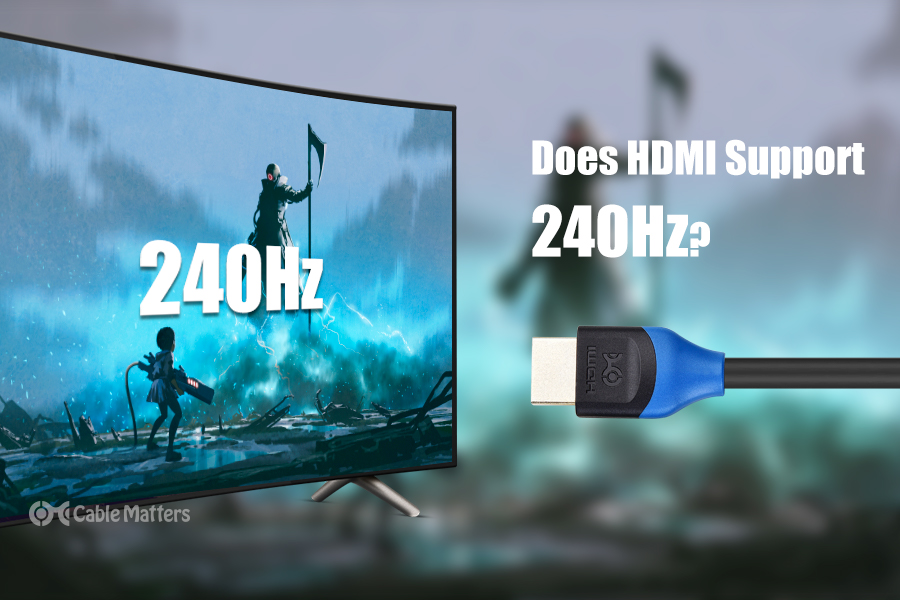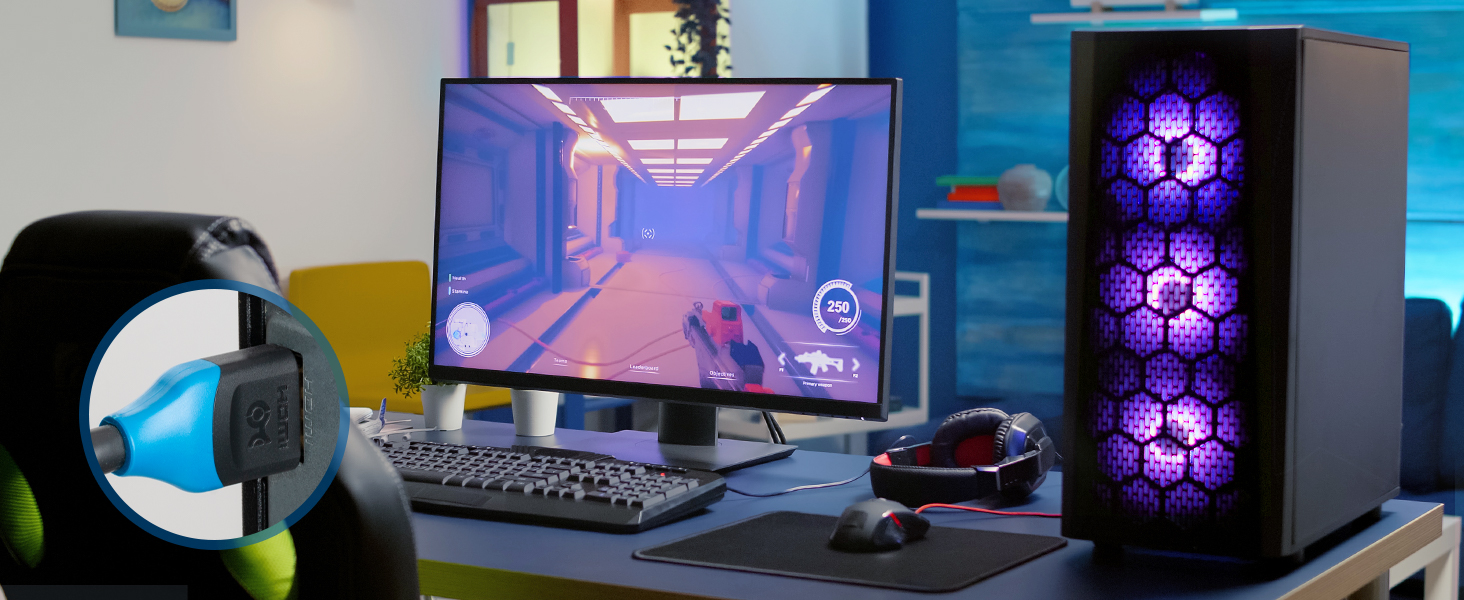
Playing games at higher frame rates has all sorts of benefits, especially if you’re playing on a high refresh rate monitor. But with even 4K monitors now supporting high refresh rates all the way up to 240Hz, it’s important to know whether the cables you’re using can actually handle all of that data. If you’re looking to make the most of your 240Hz monitor, you need to know: does HDMI support 240Hz?
Because otherwise, you’ll need to use DisplayPort. That’s not a big deal because all gaming monitors use DisplayPort as their primary connection, but if you want to use HDMI, then it’s important you know what it can do.
So, does HDMI support 240Hz? Yes. Absolutely it does. But only certain generations can handle certain resolutions at that kind of refresh rate. If you’re looking to enjoy a smooth 240Hz refresh rate for high-paced gaming, then you need to be aware of what kind of HDMI connection you can use.
Brief Overview of HDMI
HDMI cables have been a mainstay of consumer devices in living rooms and gaming rooms for well over a decade. Having replaced all of the aging analog (and some digital) connections in the ‘00s, HDMI has become the dominant way to connect TVs to game consoles, Blu-ray players, set-top boxes, and A/V systems, thanks to its support of ARC and eARC technology.
It is a combined audio and video interface technology and is typically used to carry both at the same time, although in ARC and eARC configurations, it can be used primarily as an audio transmission interface. It’s a relatively compact connector and cables can run several meters – especially if using an active HDMI cable – but the higher specification cables can only run a couple of meters before they run into problems with signal attenuation.
Over the years HDMI cables have evolved considerably, and though the connector may be the same non-reversible, 19-pin arrangement today, its capabilities have vastly improved. From 1080p 60Hz support with the first generation, HDMI cables evolved to support 1440p, and 4K, and refresh rates like 144Hz, and 240Hz. The latest generation, HDMI 2.1, introduced the landmark 4K 120Hz support, which unlocked next-generation gaming from the latest Xbox and PlayStation consoles.
For the purpose of our question today, though, “does HDMI support 240Hz,” the crucial innovation comes at 1440p, where 240Hz is entirely possible without any compression or chroma subsampling.
HDMI 2.1 cables can technically support 240Hz at 4K if it uses display stream compression, but that’s not ideal for gaming as it can introduce visual artifacts. For lower resolutions, however, like 1440p or 1080p, it has no trouble managing that without compression.
Although HDMI 2.1 is the most impressive HDMI connection to date, it still faces stiff competition from the likes of DisplayPort 1.4, which doesn’t have the same data rate, but can support many of the same resolution and refresh rates. It is also competing directly with USB4 and Thunderbolt 4 and Thunderbolt 3 cables, which offer comparable data rates for supporting ultra-high definition displays at high refresh rates, as well as data transfer and power delivery in the same connection.
HDMI has a significant advantage when it comes to support from both displays and devices, but these other standards have their niches, and HDMI development needs to continue if it will be able to compete with the likes of DisplayPort 2.1, which is going to start seeing increased support in 2023 and beyond.
Benefits of 240Hz for Users
Now that you know HDMI supports 240Hz, the question becomes: is it worth it? High refresh rates have been known for some time to help reduce input lag between the gamer clicking their mouse or tapping their keyboard and their action being represented on screen. There are a number of steps along that path that can introduce latency: the processing time of the peripheral or controller, the polling rate of the USB or wireless connection, the processing time of the computer itself, the frame rate the graphics card runs at, the input lag of your display, and its refresh rate.
There are also a number of technologies offered by Windows, and both Nvidia and AMD as part of their GPU drivers, that can help reduce input lag considerably.
All of these factors play a part in how fast you can react in-game – not to mention your own reaction speed. But one of the most popular ways of reducing that overall latency in recent years has been with the use of high refresh rate monitors, as they can make a tangible difference to not only how fast you are, but how fast you feel.
A 240Hz refresh rate is 70% faster than a 144Hz refresh rate, and four times faster than a 60Hz refresh rate, but that doesn’t equate to such a dramatic difference when you break it down. A 60Hz display has around 16.7ms time between frames, while a 144Hz display has a 7ms time between frames, and a 240hz display has a 4.2 millisecond time between frames.
So a 240Hz monitor cuts down another nearly 3ms from your reaction time, compared to a slower 144Hz monitor. That will make all the difference in a game where everything else is equal, but it’s not likely to be a game-winner for you. What might, is how much more information 240Hz gives you, over another gamer.

At 240Hz you are seeing information appear more often, at a quicker pace. That means that while your opponent is moving, you have a more accurate idea of where they are at any time than someone on a slower monitor, simply because your monitor updates more often, and therefore more recently, from your perspective.
Ultimately, however, average gamers aren’t going to notice much of a difference between a 144Hz display and a 240Hz display. The game will feel slightly more responsive to the most competitive of players, but unless you are really trying to maximize your performance for Esports, it’s arguably not needed. If you are interested in pushing your gaming skills to their limits, you probably want to consider even higher refresh rates too, like the latest 360Hz 1080p displays. You will be restricted to lower resolutions there, but you’ll be able to get the most responsive gaming displays for the greatest competitive advantage.
Still, even if you aren’t a high-end competitive Esports player, there are other benefits to having a high refresh rate display, like a 240Hz gaming monitor. Day-to-day activities on a 240Hz monitor enjoy smoother animations and can make games feel more immersive – especially when it comes to your own movements, which are far more fluid at 240Hz than at 60Hz or even 120Hz. But to take full advantage of that, you need a gaming PC that can output a frame rate for your chosen game that is at least as high as the refresh rate, and preferably higher so that there is always another frame waiting and you have access to the most up to date information possible.
That isn’t too demanding for 1080p, but if you are trying to run one of the newer 1440p 240Hz displays or even one of the high-end 4K 240Hz displays, you’ll need a computer with the most powerful of modern graphics cards to even hope to approach such frame rates. The best option is the Nvidia RTX 4090, but the RTX 4080 and RX 7900 XTX from AMD are viable alternatives, too. You’ll want a powerful CPU from Intel’s 13th generation, or AMD’s Ryzen 7000 generation, as though CPU performance isn’t typically important at higher resolutions, it is if you want high frame rates too.
Does HDMI 2.0 Support 240Hz?
There are only two generations of HDMI that you can fairly ask, does HDMI support 240Hz? One of those is HDMI 2.1, and the other is HDMI 2.0. The latter actually introduced 240Hz refresh rates to HDMI cables for the first time, with all previous versions facing the use of chroma subsampling to manage those kinds of high refresh rates, and even then, only at 1080p resolution.
HDMI 2.0 wasn’t the massive performance uplift of HDMI 2.1, but it still almost doubled the maximum data rate of HDMI 1.4 and introduced some important features, like support for DSC and ARC. However, when it comes to refresh rates and resolutions, it massively expanded HDMI capabilities. HDMI 2.0 cables can manage 240Hz at 1080p with no compression or alteration to the signal whatsoever, and they can manage up to 144Hz at 1440p, and 60Hz at 4K.
It can technically handle 1440p at 144Hz, but it needs to use chroma subsampling, which arguably makes the exercise pointless since it has such a dramatic effect on image quality.
HDMI 2.0 is best suited for lower resolutions and refresh rates, with HDMI 2.1 opening up the standard to much higher performance settings. If your display or device doesn’t support HDMI 2.1, then you may be better off using DisplayPort instead, as that has a much higher data rate than HDMI 2.0, with full support for 240Hz at 1440p or 1080p, and up to 120Hz at 4K.